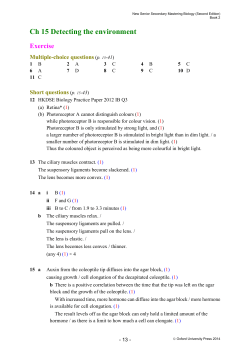
WORKSHEET PLANT HORMONES 1.1 Various possible options are
WORKSHEET PLANT HORMONES 1.1 Various possible options are provided as answers for the following questions. Select the correct answer and write only the letter (A – D) next to the question number (1.1.1 – 1.1.3), for example 1.1.1 D. 1.1.1 Which one of the following movements in plants is because of the working of the auxins? A B C D curvature of the top of the stem toward sunlight sleep movements of leaves the opening of stomata rolling up of many grass leaves in dry weather 1.1.2 The principal effect of auxins causing tropism is to increase the rate of: A B C D cell division cell enlargement cell elongation cell differentiation 1.1.3 If a coleoptile (sheath surrounding a young shoot) received light from one side only and the cells were then examined under a microscope, what would the cells on the lighter side look like in comparison with those on the dark side? On the lighter side they would be: A B C D longer shorter more numerous less numerous 1.1.4 A substance which causes different rates of growth in opposite of a plant is called: A B C D an auxin an enzyme ATP an antibody Study the diagram and answer questions1.1.5 to 1.1.7 Y W Z stem Y 1.1.5 Certain substances causes the tip of a stem to grow towards the light because of cell elongation. Where is the most cell elongation taking place in the diagram? A B C D X Y W Z 1.1.6 What causes this cell elongation? A B C D auxins ethylene cytokinins auxins 1.1.7 In what area on the above diagram is the substances synthesised? A B C D W Y X Z Study the following diagram and answer questions 1.18 and 1.1.9 Light rays 1.1.8 Which one of the following steps can be carried out as a control for this experiment? (1) (2) (3) (4) Seal the opening in the dark box. Rotate a similar plant on a clinostat in a dark box. Take the plant outside the box and expose it evenly to light. Rotate a similar plant on a clinostat with no box. A B C D only step 1 only step 2 steps 1 and 2 steps 1,3 and 4 1.1.9 The reaction of the plant in the experiment happens because growth substances … A stimulates cell elongation on the shade side. B inhibits cell elongation on the shade side. C is only formed in the presence of light. D cannot function in the dark. 1.2 Give the correct biological term for each of the following descriptions. Write only the term next to the question number (1.2.1 – 1.2.5). 1.2.1 Cells that stimulates cell elongation on the shades side. 1.2.2 Plant substance that act as a growth inhibitor. 1.2.3 Changes in the position of leaves at night. 1.2.4 Movement of a part of a body in response to a stimulus. 1.2.5 The tissue in which the auxins in plants is mainly produced 1.2.6 The movement of roots downwards 1.2.7 A growth response of a plant to the stimulus of light 1.2.8 The main hormone controlling leaf abscission 1.2.9 Stimulates cell division in meristematic tissue 1.2.10 The apparatus which is used for demonstrating geotropic growth 1.3 Match the items in COLUMN II with the statements in COLUMN I. Write only the letter of the correct answer next to the question number (1.3.1 - 1.3.4), for example 1.3.5 D COLUMN I COLUMN II 1.3.1 Response to light A Senescene 1.3.2 Substance that causes growths in a opposite sides of a plant B Phototropism C Auxin D Geotropism E Hormones F Abscisic acid G Gibberellins 1.3.3 Slowing down or aging of a plant 1.3.4 Tropic response to pull of earth 1.3.5 Inhibits growth in apical buds and seeds (5 x 1) (5) 1.4 The diagram shows how the movement of auxin through plant shoots was investigated. Shoots were removed from young plants and each was placed on a block of agar. A second block of agar was placed in the side of each shoot where a portion of its tissue had been cut away. Samples of shoots treated in this way were left for several hours. Half the shoots were left in darkness and half were left with a light source from one side. The concentration of auxin collected in the two blocks of agar from each shoot was measured. The table shows the mean percentage of auxin found in the two blocks of agar from each shoot. Cut shoot Agar block in side of shoot Source of light for those shoots left in light Agar block in base of shoot Location of block Side of shoot Base of shoot Both blocks Mean percentage of auxin collected in the two agar blocks from each shoot Shoot in dark Shoot lit from side 27 35 73 65 100 100 1.4.1 What do the results of this investigation show about the movement of auxin? (2) 1.4.2 Explain how the movement of auxin shown in this experiment enables intact plants to photosynthesise efficiently. (3) 1.4.3 Give a hypothesis for this investigation. (2) 1.4.4 List the dependant and independent variables. (2) 2. The graph shows the response of oats seedlings to various concentrations of externally applied auxin. %change in length compared with control +20 shoot +10 root 0 -10 10-6 10-4 10-2 1 102 104 Auxin concentration/ppm 2.1.1 Give TWO differences between the responses of shoots and roots shown by the graph. (2) 2.1.2 Suggest a suitable control of this investigation. (3) 2.1.3 Describe how the action of auxin on cells of the shoot promotes growth. (4) 2.1.4 Explain why auxins may be used as selective weed killers in cereal crops. (2) 2.1.5 At what concentration of auxins do shoots show the most growth? (2) 2.1.6 At what concentration of auxins does growth begin to be inhibited in roots? (2) 2.1.7 Name TWO places in plants where auxins are produced (2) 2.1.8 Explain the role of auxins in apical dominance (4) 3.1 List THREE substances for plant growth and describe their main functions. (9) 4. Tropic responses can be analysed in terms of Stimulus – receptor- transmission- effector – response If a coleoptile is stimulated by a light source from one side and response by bending towards that light source what is: 4.1.1 the receptor (1) 4.1.2 the effector of the response (1) 4.1.3 How is transmission between receptor and effector achieved? (2) [4] 5. Study the drawing below and answer the questions that follow. After a few days part A starts growing upwards. A Y Root X A Germinating seed pinned horizontally on moist cotton wool 5.1.1 Which hormone is responsible for this phenomenon? 5.1.2 On which side (X or Y) will the concentration of this hormone be greater? 5.1.3 Give a possible reason for the higher concentration of the hormone named in QUESTION 5.1.2. 6. (1) (1) (2) (4) Plants often respond to external stimuli by means of growth movements Discuss the different growth movements and the substances that causes it. [20]
© Copyright 2025
















